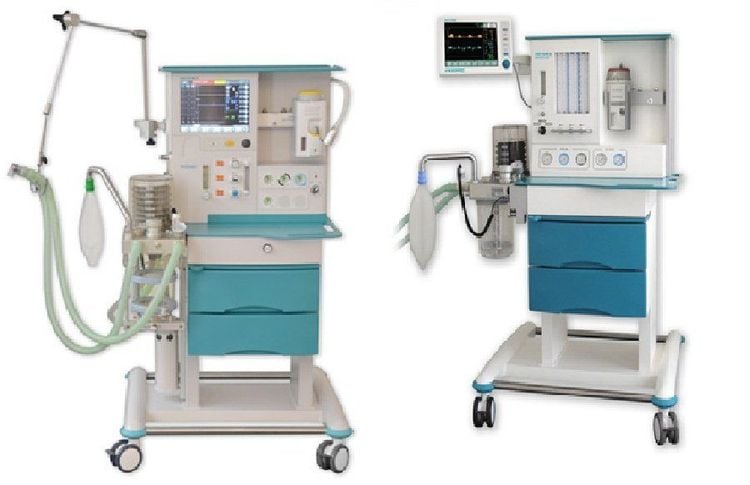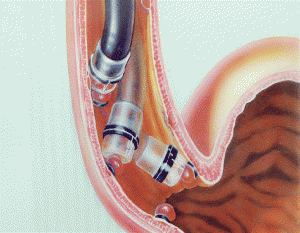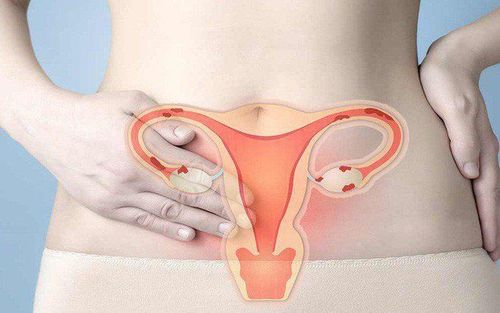This is an automatically translated article.
The article was professionally consulted by BSCK I Nguyen Xuan Tinh - Anesthesiologist - Resuscitation - Department of General Surgery - Vinmec Phu Quoc International General Hospital.One of the numbing methods when performing anterior ovarian tumor removal or ovarian tumor removal is endotracheal anesthesia. Under anesthesia, the patient was intubated throughout the surgery and recovered after surgery.
1. Outline
Ovarian cyst is an abnormal growth in the ovary. Indications for surgical removal or removal of ovarian tumors when the tumor is twisted, large, suspected or ovarian cancer... Ovarian removal or dissection surgery can be laparoscopic or surgical surgery. open.Laparoscopic ovarian surgery has many advantages over open surgery, but there are some cases where open surgery is still indicated due to contraindications to laparoscopic surgery. Choosing the right surgical method depends on each case. Regardless of the surgical method, an anesthetic is required, endotracheal anesthesia is the general anesthetic method of choice often in surgery.
Endotracheal anesthesia for ovarian tumor removal or ovarian tumor removal is a method of general anesthesia with intubation for the purpose of breathing control during surgery and postoperative resuscitation, patients You will sleep during the surgery.

U buồng trứng có thể ảnh hưởng đến khả năng sinh sản của phụ nữ
2. Indications and contraindications
2.1 Designation
Surgical removal or removal of ovarian tumors due to ovarian torsion, large tumor or ovarian cancer. Respiratory control with a mask is difficult. Maintain anesthesia with inhalation anesthetics
2.2 Contraindications
The patient is menstruating or has abnormal bleeding that has not stopped or has not been cured. Having an infection or blood disease. Patients with medical conditions unable to tolerate surgery Patients who do not agree There are insufficient facilities for anesthesia and resuscitation and the person performing anesthesia is not technically proficient.

Bệnh nhân đang trong thời kì kinh nguyệt chống chỉ định thực hiện thủ thuật
3. Endotracheal anesthesia procedure
3.1 Preparation
Performer: Doctor, nurse in anesthesiology and resuscitation department. Technical means: Anesthesia machine system with ventilator; balloon oxygen source; monitor vital functions including electrocardiogram, arterial blood pressure, SpO2, EtCO2, temperature, breathing rate; defibrillator, phlegm aspirator. Laryngoscope, endotracheal tube of different sizes, suction tube, mask, bulb, oropharyngeal cannula, Magill pliers, soft mandrin. Medicines: Prepare drugs used in anesthesia resuscitation and handling of accidents. Other means of precaution in case of difficult intubation: Cook tube, laryngeal mask, flexible bronchoscope, mouth opener, tracheostomy kit... Patient: Full pre-anesthesia examination , detect and prevent the risk of accidents that may occur. Advice and explanation of possible complications in anesthesia and surgery to remove ovarian tumors or remove ovarian tumors. Risk assessment of cases at risk of difficult intubation. Use sedation the night before surgery if needed.

Hình ảnh hệ thống máy gây mê kèm máy thở
3.2 Steps to take
Patient:
Patient position: Lie on back, breathe 100% oxygen 3-6 l/min at least 5 minutes before induction of anesthesia. Install a vital sign monitor, if the patient has laparoscopic ovarian surgery, the EtCO2 parameter must be provided. Establish an effective infusion and administer pharmacological pre-anesthesia. Anesthesia:
Anesthesia can be initiated by intravenous anesthetic, inhalation or a combination of the two. Combining some drugs to increase the effect of anesthetics such as: opioid pain relievers (morphine, fentanyl..), muscle relaxants if necessary. Oral intubation: The condition for intubation is that when the patient is in deep sleep, the degree of muscle relaxation is sufficient in most cases.
Open the mouth, put one hand under the neck to help straighten the neck, then put the laryngoscope to the right of the mouth, move the patient's tongue to the left, push the light deeply, coordinate with the right hand to press down on the cricoid cartilage and find the lid glottis, orifice.

Bệnh nhân được hướng dẫn nằm ngửa khi đặt nội khí quản bằng đường miệng
Perform rapid induction of anesthesia and the Sellick maneuver in cases of full stomach. Pass the endotracheal tube gently through the glottis, stopping when the balloon of the endotracheal tube passes about 2-3 cm across the vocal cords. Remove the laryngoscope and inflate the endotracheal balloon. Check that the endotracheal tube is in the correct position by auscultation and EtCO2 results. Secure the tube with tape and place the canul in the mouth to prevent biting the tube (if necessary). In cases of difficult intubation, a difficult intubation procedure should be used. Maintenance of anesthesia: Maintain anesthesia with intravenous or inhalation anesthetics, analgesics and muscle relaxants (if needed).
Monitoring:
Need to control breathing with a ventilator or hand-held oxygen source. Monitoring the depth of anesthesia based on heart rate, arterial blood pressure, sweating, tearing... Monitor signs and prevent cases of endotracheal intubation in the wrong position, folding...
3.3 Standards for extubation
When the surgery is completed, the endotracheal tube should be extubated when the following criteria are met:
The patient is awake and follows orders; Lift head for more than 5 seconds, TOF >0.9 (if any); Spontaneous breathing, breathing rate within normal limits; Stable pulse and blood pressure; Body temperature > 35 degrees Celsius; There were no complications from anesthesia and after surgery.
4. Complications and management of complications due to intubation
4.1 Reflux of gastric juice into the airway
Signs: There is digestive fluid in the oral cavity and airways. Treatment: Drain the fluid, place the patient in a low lying position, tilt the head to one side; Rapid intubation of the endotracheal tube and aspiration of the airway fluid; Monitoring and prevention of lung infections after surgery,

Trào ngược dịch dạ dày vào đường thở là một tai biến thường gặp do đặt nội khí quản
4.2 Hemodynamic disorders
Hypotension or hypertension, arrhythmia (may be bradycardia, tachycardia, arrhythmia). Treatment depends on the signs and causes.
4.3 Complications due to intubation
Failed to intubate: Re-intubate following difficult intubation procedure or switch to another method of anesthesia. Misplaced in the stomach: Signs: Auscultation of the lungs without alveolar murmurs, no measurement of EtCO2. Treatment: Reinsert the endotracheal tube. Vocal, air, and bronchial spasms Difficult or impossible to ventilate the lungs due to spasm, auscultation with rales or muted lungs. Management: Provide adequate oxygen, add sleeping pills and muscle relaxants, ensure ventilation, give bronchodilators and corticosteroids; If breathing is not controlled, a difficult intubation procedure should be used. Injuries when inserting a tube include: Bleeding, broken teeth, damage to the vocal cords, falling foreign bodies into the airways... Need to be handled depending on the injury.
4.4 Respiratory complications
Folding, intubation of the endotracheal tube, causing the endotracheal tube to be pushed deep into one lung, retracting or opening the respiratory system, running out of oxygen...
Treatment: Need to ensure ventilation and provide 100% oxygen immediately , resolve the cause.

Người bệnh có thể gặp biến chứng hô hấp do đặt nội khí quản
4.5 Complications after extubation
Respiratory failure after extubation can have many causes. Sore throat hoarse voice. Constriction of the larynx, trachea and bronchi. Inflammation of the upper respiratory tract. Narrow larynx, trachea. Treat the patient on a case-by-case basis and on a case-by-case basis.
Endotracheal anesthesia is a very important step in a surgery. Therefore, the anesthetic process needs a team of medical professionals who are technically proficient, helping to limit accidents during anesthesia.
Vinmec International General Hospital is one of the hospitals that not only ensures professional quality with a team of leading medical doctors, modern equipment and technology, but also stands out for its examination and consultation services. comprehensive and professional medical consultation and treatment; civilized, polite, safe and sterile medical examination and treatment space. Customers when choosing to perform tests here can be completely assured of the accuracy of test results.
Doctor Nguyen Xuan Tinh has more than 18 years of experience studying and working in the field of Anesthesia - Resuscitation. Before working as an anesthesiologist at the Department of General Surgery - Vinmec Phu Quoc International General Hospital, Dr. Tinh worked for a long time at Cam Xuyen Tinh District General Hospital, Ha Tinh.
Customers can directly go to Vinmec Health system nationwide to visit or contact the hotline here for support.














